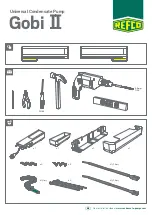
13
TROUBLE SHOOTING GUIDES CONTINUED
General Refrigeration Circuit
Continued
SYMPTOM
POSSIBLE CAUSE
REMEDY
1.Blower rotational noise.
1. Check blower, motor and drive for faulty adjustment or noisy bearings, loose parts, blower out of
balance.
2.Air noise.
2. Check ductwork. Air velocity too high.
3.Chattering contactor.
3. Check for adequate control voltage, check for shorts or breaks, check thermostat, check contact
points.
4.Tubing rattle.
4. Dampen by taping or clamping, bend tubing away from contact when possible.
1.Excessive load on evaporator coil.
1. Check for high entering wet bulb temperature. Check for excessive airflow.
2.Broken compressor valves (Scroll compressors do not
have valves.)
2. Remove head (semi-herm.) inspect reeds. Scroll compressors should not be pumped down below 5
psig.
3.Compressor is unloaded.
3. Check head pressure, check and adjust TXV if not functioning properly, check pressure drop across
filter drier. Re-calibrate unloader pressure switch.
4.Leaking check valve.
4. Check temperature across check valve.
5.Expansion valve not secured to suction line or TXV
defective.
5. Check the TXV, ensure bulb is insulated.
1.TXV setting.
1. Check TXV setting and calibrate superheat.
2.Air inlet to condenser dirty or obstructed.
2. Check for proper clearances and possible air recirculating.
3.Condenser fan motor defective.
3. Check condenser fan motor and run capacitor.
4.Condenser fan control has incorrect setting.
4. Check calibration of low ambient head pressure control.
1.Refrigerant undercharge.
1. Check pressures and subcooling.
2.Blower running backward.
2. Interchange any two wires from 3 phase disconnect.
3.Loose blower, pulley or belts.
3. Check drive pulley alignment, belt tension.
4.Defective or improperly adjusted expansion valve.
4. Check superheat and adjust TXV.
5.Dirty filter.
5. Check filter and evaporator coil.
6.Too little air flow or low entering air temperature.
6. Check airflow and entering air wet bulb conditions.
7.Restriction in suction or liquid line.
7. Check refrigerant circuit for restriction
1.Insufficient refrigerant charge.
1. Check subcooling, check for leak.
2.Defective or improperly adjusted expansion valve.
2. Check sub cooling and adjust TXV.
3.Low suction pressure.
3. See “suction pressure too low” above.
4.Condenser fan control setting.
4. Check calibration of low ambient control.
5.Defective compressor.
5. See “high suction pressure” above.
1.Thermostat location or malfunction.
1. Check thermostat, check heat anticipator setting.
2.Improper refrigerant charge.
2. Check subcooling, verify superheat.
3.Defective high or low pressure control.
3. Check high or low pressure switch.
4.Liquid floodback.
4. Possible tight bearings.
5.Defective expansion valve.
5. Check TXV and superheat.
6.Poor air distribution.
6. Check ductwork for recirculating.
7.High discharge pressure.
7. See “high discharge pressure” above.
8.Leaking discharge valves in compressor.
8. See “high suction pressure” above.
1.Refrigeration undercharged.
1. Check subcooling.
2.Dirty filter or evaporator coil.
2. Check filter, coil and airflow.
3Dirty or clogged condenser coil.
3. Check coil and airflow.
4.Air or other non-condensables in system.
4. Check equalized high side pressure with equivalent outdoor temperature.
5.Defective compressor.
5. Check compressor for proper operation.
6.Restriction in suction and liquid line.
6. Check for restrictions in refrigerant circuit.
7.Control contacts stuck.
7. Check thermostat, shorts in wiring, slave relay compressor contactor
M.Running cycle too long or unit
operates continuously.
G.Noisy unit operation.
H.High suction pressure.
L.Compressor short cycles.
K.Head pressure too low.
J.Suction pressure too low.
I.High discharge pressure.
Содержание B
Страница 19: ...19 ...





































